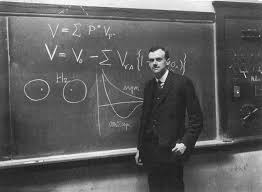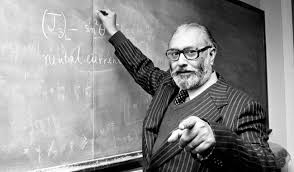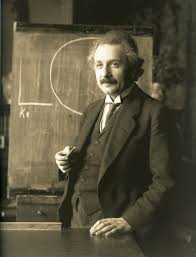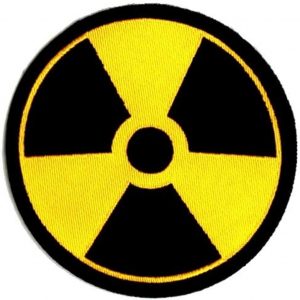A Theory of Everything, TOE, is one that unifies, in a mathematical equation, all the four known interactions (major forces) in the Universe.
TOE will make it possible for all four to be handled with one equation instead of using a different partial approach for each interaction.
BASICS
Since the British physicist, Ernest Rutherford (1871 –1937), split the atom in 1919, it became known that an atom is not indivisible, after all.
He did this when he first saw that it was easy to obtain the nucleus of a Helium atom.
He then got many and used them to bombard Nitrogen atoms to obtain Hydrogen (another element) with the release of protons.
This way, he discovered protons which are the positively charged part of the nucleus of every atom.

Then in 1932, another British physicist, Sir James Chadwick, discovered the neutron, a part of the nucleus of an atom which has no charge.
It used to be thought, about then, that there were three fundamental particles in an atom – the electron (negatively charged) discovered in 1887 by the British physicist, J. J. Thomson; then, the positively charged protons, discovered in 1919 by Ernest Rutherford; and neutrons (which have no charge) discovered in 1932 by Sir James Chadwick.

By today, 36 subatomic particles have been discovered.
Some of these subatomic particles were discovered by California Institute of Technology physicist, Murray Gell-Mann (1929 – 2019) in 1964, when in high speed experiments with protons and electrons; protons collided with protons.

This was surprising because protons are positively charged and are supposed to repel themselves.
Like-forces repel; opposite forces attract.
This goes to suggest that while protons may be positively charged, they are made-up of more fundamental particles that have different charges.
He discovered that they were made of subatomic particles called quarks.
Quarks were also found to make up neutrons.
So, the elementary particles are the quarks – making up Protons and Neutrons – and the electron.
They are fundamental because they cannot be broken down into smaller units.
Some scientists have however, proposed a Preon as the fundamental particle (making up quarks and leptons).
This is at best theoretical.
CONCEPTS
Scientists developed the Standard Model which, except for gravity, explains all the matter-force interactions in nature (Matter is anything that has mass and occupies space).
They identified two types of particles:
The first type is Matter Particle, like the elementary particles – electrons and quarks – which make-up all matter;
and
The second type: Force Carrying Particle which is supposed to carry, or convey, the matter particles.
All matter particles also have their equivalent anti-matter particles.

The English physicist, Paul Dirac (1902 –1984) who shared the Nobel Prize in Physics in 1933 with the Austrian physicist, Erwin Schrödinger (1887 –1961), predicted the existence of antiparticle which annihilates when it collides with its matter particle leaving energy behind.
He predicted the existence of a positron, an antielectron, identical to the electron but opposite in charge, as he used Einstein’s Special Theory of Relativity to study the spin of the electron.
The antielectron was discovered in 1932 by the American physicist, Carl Anderson.
Owen Chamberlain, another American physicist, in 1955 confirmed that an antiproton exists.
The idea of an anti-particle was well-explained by Stephen Hawking in an analogy.
He said a man digging, makes a hole in the ground and a mound beside as he shovels out the dug soil.
Think of the mound as the “particle” and the hole as “anti-particle.”
If the mound is put back into the hole, just as it was dug out, the particle and anti-particle annihilate. Both the mound (particle) and hole (antiparticle) disappear.

So, an antimatter particle exists for every matter particle.
Scientists discovered some other elementary particles – muon, tau and three neutrinos.
It became convenient to group them with the electron as Leptons.
Under the Standard Model, the Matter Particles are made up of six types of Leptons – electron, muon, tau, and three neutrinos – and all the quarks.
Neutrinos have no charge and are mass-less or have very little mass.
The electron, muon and tau are all negatively charged and each has one corresponding neutrino.
Neutrinos were first predicted by the Austrian physicist, Wolfgang Pauli (1900 –1958) in 1931.The name neutrino was given by the Italian physicist, Enrico Fermi (1901 –1954).
Muons were found in 1936; neutrinos in 1956 and the tau in 1975.
The electron is the most popular Lepton.
There are also six types (sometimes called Flavours) of Quarks.
They are: Up, Down, Charm, Strange, Top and Bottom.
Unlike electrons with whole number or integer charge of –1 and protons +1, quarks have their electric charge in fractions:
up ⅔ down -⅓
charm ⅔ strange -⅓
top ⅔ bottom -⅓
Quarks come together to form Hadrons to have a charge of a whole number. (A quark is also said to have a colour charge, but Hadrons have no colour charge).
There are two classes of Hadrons: The first class is Baryons, made-up of three quarks.
An example is a proton – made-up of two Up quarks and one Down quark.
Neutrons are made-up of one Up quark and two Down quarks.
The second class of Hadrons is Mesons which contain one quark and one anti-quark.
An example of this, pi-meson or Pion, was predicted by the Japanese scientist, Hideki Yukawa (1907 –1981) for which he won the Nobel Prize in Physics in 1949.

It was discovered in 1947.
In a quark-antiquark pair in Mesons, a quark pairs another antiquark that is not its own, and so does not annihilate as expected in matter-antimatter meeting as postulated by Paul Dirac.
An Up quark can pair a Down antiquark to form a Pion meson with an electric charge of +1; or a Down quark with an Up antiquark to form a Pion meson with an electric charge of -1.
An Up – anti-Up quark pair or Down – anti-Down quark pair will have an electric charge of 0 but will annihilate.
An example of a meson is a Kaon with one Up or Down quark and one Strange quark. However, one of them – Up, Down, Strange – must be an anti-quark.
Unlike leptons that can exist alone, quarks are not found alone and are found as baryons or mesons.
The Top quark which is massive was discovered in Fermilab in Illinois, USA, in April, 1995.
In the Standard Model, there are also the Force carrier particles that carry these Matter particles in the interaction.
One of such is the Photon which is the carrier particle in electromagnetism.
An electric charge that is positive attracts the negative charge because they are opposite – not like-forces. Like-forces repel.
These are manifestations of electromagnetism.
Photons bind the electrons to the protons in the nucleus of the atom which contains the protons and neutrons (electrons are negatively charged, while the protons are positively charged; neutrons have no charge).
Four forces are known to govern all interactions in the Universe.
These are: Electromagnetism, Gravitation, Strong force and Weak force.
The graviton, yet to be discovered, is believed to be the carrier particle for gravity.
The next force (after electromagnetism and gravity) is the Strong Force which is the force that holds quarks together into Hadrons.
This is the strongest of the four forces and binds protons together despite the fact that each of them has an overall positive charge and normally repels each other in a nucleus.
It also binds the neutrons to the protons in atomic nucleus. It is therefore short-range.
Its carrier particles are the Gluons. (Only quarks and gluons have colour charge. Hadrons do not have colour).
The Strong Force is believed to be six thousand trillion, trillion, trillion (36 zeros after 6) times stronger than gravity.
Another force, the Weak Force, governs the decay of quarks in unstable nuclei into lighter quarks; or a lepton to lighter lepton.
Massive quarks can decay to yield two lightest quarks like Up and Down quarks; while leptons like a muon can yield electrons.
This is why stable matter in the Universe is made of two smallest quarks – Up and Down – and the least charged lepton: the electron.
In radioactive decay, the decaying nuclei also give rise to alpha or beta particles or gamma radiation; while in beta decay neutrons yield protons and electrons.
The carrier particles for the Weak force are the W+, W- and Z bosons which are all massive.
The Z boson is neutral while the Ws are charged.
The Weak force is weaker than electromagnetism; the Strong force is the strongest, while Gravity is the weakest.
Physicists sometimes classify particles in terms of their spin or internal angular momentum as Boson or Fermion.
Bosons have whole number spin like 0, 1, 2.
Fermions, on the other hand, have odd half whole number spin like ½, 3/2.
Particle Physicists use these terms a lot as in Pauli’s Exclusion Principle which states that no two particles in the same state – identical spin, colour charge, angular momentum – can be in same place at same time.


Fermions are subject to Pauli’s exclusion but bosons are not subject to Pauli’s exclusion.
A Theory of Everything
A Theory of Everything, sometimes called Grand Unified Theory or Quantum-Gravity Unification, is one that will unify the interactions of the four fundamental forces in the Universe. It has to do so in a mathematical equation.
This will provide a common platform for work in all of them, instead of scientists working on any of the fundamental forces using a partial approach.
It is like blind men studying an elephant: one touching the tusk says an elephant is ivory, one touching the side; a wall, the leg; timber, the tail; a snake and so on.
A unification says what an elephant is, best.
Taking the elephant analogously as the Universe, unification of these fundamental forces – electromagnetism, strong force, weak force, gravity – will be the best and single approach towards fully understanding all the interactions in the Universe.
The Pakistani physicist, Abdus Salam, and the American, Steven Weinberg, unified Electromagnetism and the Weak force.
This means that both of them can be handled in a single equation.

Professor Abdus Salam
This is considered significant.
Abdus Salam and Weinberg in their unified Electroweak interaction (electromagnetism and weak force) proposed a particle, a neutral Boson called the Z o, as carrier for a Weak interaction, and a very massive Boson called the Higgs boson as carrier in the unification.
In the Standard Model used by scientists, for Matter (particles) to interact, as already known, they must have Carrier particles to carry or convey them.
Photons are mass-less and are the carrier particles for Electromagnetism.
The Z o for this Weak interaction and Photon for Electromagnetism, are unified in a Higgs field by Higgs boson as carrier particle.
They found that Weak nuclear force and Electromagnetism look different at low energy levels in everyday life.
However, over the unification energy (102 GeV) they merge into a single Electroweak force.

As the hot early Universe cooled to this energy level after the Big Bang, there was spontaneous symmetry breaking in the so-called Higgs field which accounted for the difference in mass of some particles.
For instance, the photons have no mass but the W and Z bosons are massive.
Spontaneous symmetry breaking refers to particles or atoms re-aligning under their own electromagnetic influences, or changing symmetry, as in water molecules freezing to ice or, changing from ice to water, as the temperature changes.
Both Abdus Salam and Steven Weinberg shared the Nobel Prize in Physics in 1979 with the American, Sheldon Glashow, for this unification of Electromagnetism and Weak force.

The European Council for Nuclear Research, CERN, in Switzerland, produced the W and Z particles in 1983, which were used to confirm the Electroweak interaction in a proton – antiproton collision.
CERN has a Large Hadron Collider, LHC, which is 27 kilometres (17 miles) long, that fires particles at high speed to study their collision in research in high energy physics.
Higgs particles (Electroweak interaction) as well as all force carrier particles – including gluons (Strong force), the W and Z bosons (Weak force) and photons (Electromagnetism) – are all bosons.
Also some composite particles like mesons (quark-antiquark pair) are also bosons.
Leptons (group for particles – electrons, tau, muon and three neutrinos), quarks (fundamental particles that make up protons and neutrons) and their composite particles (like protons and neutrons) are all Fermions.

The Higgs boson was discovered in 2012 in CERN.
Peter Higgs shared the Nobel Prize in Physics in 2013 with François Englert for their work in discovering the Higgs boson.
The bid to unify the four fundamental interactions is sometimes summarized into Quantum-Gravity unification because it comprises the Quantum Theory – which deals with small particles – and Albert Einstein’s General Theory of Relativity – which deals with gravitation and large bodies where gravity is significant (like planets, galaxies).



The Nobel prize-winning British scientist, Paul Dirac, unified the Quantum Theory with Albert Einstein’s Special Theory of Relativity – which deals with how motion affects mass and spacetime – into a Quantum Field Theory.
However, the Quantum-Gravity unification, or Theory of Everything, TOE, which deals with the Quantum Field Theory and Einstein’s General Theory of Relativity – which, unlike the Special Theory of Relativity, includes gravity and large bodies – is yet to be achieved till today.
Albert Einstein spent the last 30 years of his life trying to unify electromagnetism and gravitation, the two known interactions during his time, without success.

He was one of the first people to start the search for a Theory of Everything.
There have been many other attempts at unification.
Theodore Kaluza and Oskar Klein attempted unifying gravitation and electromagnetism first in 1921.
Later, they extended the theory of relativity from four to five-dimensional spacetime in another unsuccessful attempt at unification.
More recently, there have been String theories.
The name came from the idea of a string that has only length and may be open or closed.
Under this theory, the Universe is thought of as being made up of tiny, vibrating strings and particles are thought of as waves in a string.
Since the String theory takes the fundamental components of matter, not as mathematical points, but one-dimensional entities like lines (strings), the way such strings vibrate, rotate, explains the behaviour of the particles.
String theory has been used to explain the properties of protons and electrons.
It was however, incomplete when some more details are required.
This gave rise to the Superstring theory which turned out to be difficult, if not impossible, to use.
It will take 1020 strings, end-to-end, to cover the diameter of a proton.
A string has a length of about 10-33 centimetre and is so small that structure of matter in that scale cannot be examined in experiments in laboratories.
To do so, you need a particle accelerator larger than the Earth.
Supersymmetry, which suggests that each particle has a “super partner” with same mass but opposite spin that differs by half a unit, was introduced. So, bosons have corresponding fermions and vice versa. No evidence of this has been found even in CERN.
In 1995, the American mathematical physicist, Edward Witten, proposed the M theory in a conference in the University of Southern California, Los Angeles.
It was found that many Superstring theories are related.
The description of one particle in one String theory can be related to the description of another particle in another String theory; suggesting an underlying theory – the M theory.
In M theory, instead of strings that vibrate as in String theory, you have membranes that flap, making-up a theory of space, time and matter.
In the end, it did not quite succeed in improving the String theory. A closed string traces out a tube as it moves through time and an open string traces out a sheet as it moves through time.
Another attempt at Grand Unification is the Loop Quantum Gravity.
This is also known as Loop Gravity or Quantum Geometry.
It proposes that the fabric of space and time is made up of tiny discrete chunks or loops, suggesting that Einstein’s space-time arises from quantum effects.
Loop Quantum Gravity is however, criticized because as it is said, no experimental observation has verified or refuted any aspect of it.
It is also said to make too many assumptions in geometry.
Richard Feynman developed the Sum Over Histories or Path Integral in 1948.
Under this theory, a particle does not follow a single path but all possible paths at once.
The final path is a sum over of the possibilities.
This adds up, or integrates, all possible histories of the system in-between the initial and final states.
He developed Feynman’s diagrams to do that.
In large systems, similar histories however, interfere or cancel each other out, leaving only one history.
While unification was not achieved under Feynman, Feynman’s diagrams are commonly used today in calculating interactions of particles in spacetime – like for electrons and anti-electrons.
He shared the Nobel Prize in Physics in 1965 with Sin-Itiro Samonaga and Julian Schwinger.
A major challenge is that gravity particles attract themselves and add-up with other interactions yielding infinitely large values which cannot be reduced to finite, manageable results.
Scientists working on unification complain of a Singularity, a mathematical condition, in which physical laws appear to break down and calculations yield ridiculous answers at some point.
Einstein’s General Theory of Relativity is mainly Geometry while Quantum Field Theory is mainly Algebra and they tend to clash when they meet.
Also, Quantum Entanglement where two particles are related even at a distance in such a way that they react to each other faster than the speed of light cannot be explained by classical physics.
A Nigerian mathematician, Gabriel Oyibo, came up with a Grand Unified Theorem he called GAGUT.
He developed a general solution: Gij, j = 0.
Using Tensor Calculus in Mathematics, he formulated that from two initial solutions – one for all waves and one for the movement of all bodies.
Since both solutions are joined in a general solution, he said, where the wave solution ends, the other takes over and vice versa.
That way, he concluded, there will not be a problem of singularity.
His theorem has not been accepted as unification.
The challenge remains unresolved.
photo credit: capitalpost. pinterest












Нighly descrіptive post, I enjoyed that a lot. Will thеre be a
part 2?
Thank you for finding the time to read us and for your kind comment.
Very best regards.